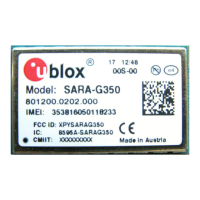SARA-G3 and SARA-U2 series - System Integration Manual
UBX-13000995 - R26 Design-in
Page 122 of 217
Guidelines for RF termination design
The RF termination must provide a characteristic impedance of 50 as well as the RF transmission line up to the
RF termination itself, to match the characteristic impedance of the ANT pin of the module.
However, real antennas do not have perfect 50 load on all the supported frequency bands. Therefore, to
reduce performance degradation due to antenna mismatch as much as possible, the RF termination must
provide optimal return loss (or V.S.W.R.) figures over all the operating frequencies, as summarized in Table 9.
If an external antenna is used, the antenna connector represents the RF termination on the PCB:
Use a suitable 50 connector providing proper PCB-to-RF-cable transition.
Strictly follow the connector manufacturer’s recommended layout, for example:
o SMA Pin-Through-Hole connectors require GND keep-out (i.e. clearance, a void area) on all the layers
around the central pin up to annular pads of the four GND posts, as shown in Figure 59.
o U.FL surface mounted connectors require no conductive traces (i.e. clearance, a void area) in the area
below the connector between the GND land pads.
Cut out the GND layer under RF connectors and close to buried vias, to remove stray capacitance and thus
keep the RF line 50 : e.g. the active pad of U.FL connectors needs to have a GND keep-out (i.e. clearance,
a void area) at least on first inner layer to reduce parasitic capacitance to ground
If an integrated antenna is used, the RF termination is represented by the integrated antenna itself:
Use an antenna designed by an antenna manufacturer, providing the best possible return loss (or V.S.W.R.).
Provide a ground plane large enough according to the related integrated antenna requirements: the ground
plane of the application PCB can be reduced to a minimum size that must be similar to one quarter of
wavelength of the minimum frequency that must be radiated. As numerical example:
Frequency = 824 MHz Wavelength = 36.4 cm Minimum GND plane size = 9.1 cm
It is highly recommended to strictly follow the detailed and specific guidelines provided by the antenna
manufacturer regarding correct installation and deployment of the antenna system, including PCB layout
and matching circuitry.
Further to the custom PCB and product restrictions, the antenna may require a tuning to comply with all the
applicable required certification schemes. It is recommended to consult the antenna manufacturer for the
design-in guidelines for the antenna related to the custom application.
Additionally, these recommendations regarding the antenna system must be followed:
Do not include antenna within closed metal case.
Do not place the antenna in close vicinity to end users, since the emitted radiation in human tissue is limited
by regulatory requirements.
Place the antenna far from sensitive analog systems or employ countermeasures to reduce electromagnetic
compatibility issues.
Take care of interaction between co-located RF systems since the GSM / UMTS transmitted RF power may
interact or disturb the performance of companion systems.
The antenna shall provide optimal efficiency figure over all the operating frequencies.
The antenna shall provide appropriate gain figure (i.e. combined antenna directivity and efficiency figure) so
that the electromagnetic field radiation intensity does not exceed the regulatory limits specified in some
countries (e.g. by FCC in the United States, as reported in section 4.2.2).
Consider including extra footprints for a “pi” network in between the cellular module and the antenna, for
further improvement in the antenna matching circuit to reach optimal antenna performance.

